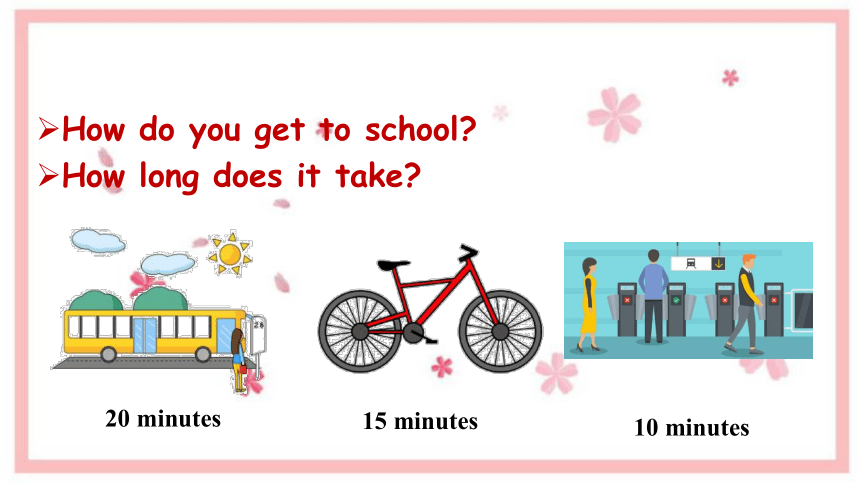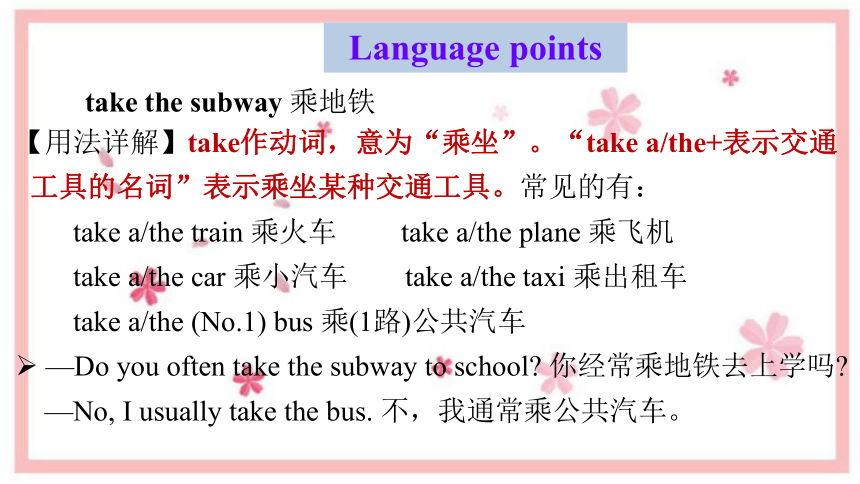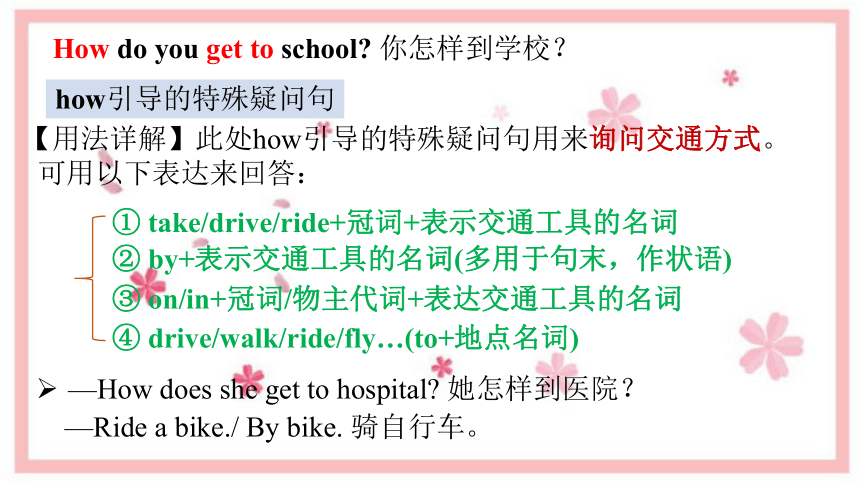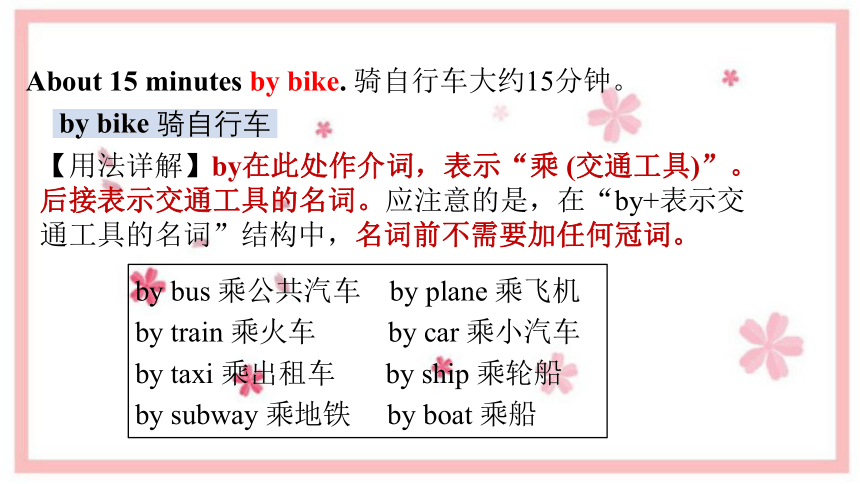七下Unit 3 How do you get to school?单元复习知识点课件(共42张PPT)
文档属性
| 名称 | 七下Unit 3 How do you get to school?单元复习知识点课件(共42张PPT) |  | |
| 格式 | zip | ||
| 文件大小 | 808.2KB | ||
| 资源类型 | 教案 | ||
| 版本资源 | 人教新目标(Go for it)版 | ||
| 科目 | 英语 | ||
| 更新时间 | 2023-04-10 21:40:33 | ||
图片预览












文档简介
(共42张PPT)
单元复习知识点课件
Unit 3
How do you get to school
How do you get to school
How long does it take
20 minutes
15 minutes
10 minutes
How does he/she go to work
How far is it from his/her home to work
7 kilometers
100 kilometers
1 kilometer
Language points
take the subway 乘地铁
【用法详解】take作动词,意为“乘坐”。“take a/the+表示交通
工具的名词”表示乘坐某种交通工具。常见的有:
take a/the train 乘火车 take a/the plane 乘飞机
take a/the car 乘小汽车 take a/the taxi 乘出租车
take a/the (No.1) bus 乘(1路)公共汽车
—Do you often take the subway to school 你经常乘地铁去上学吗
—No, I usually take the bus. 不,我通常乘公共汽车。
How do you get to school 你怎样到学校?
【用法详解】此处how引导的特殊疑问句用来询问交通方式。
可用以下表达来回答:
how引导的特殊疑问句
① take/drive/ride+冠词+表示交通工具的名词
② by+表示交通工具的名词(多用于句末,作状语)
③ on/in+冠词/物主代词+表达交通工具的名词
④ drive/walk/ride/fly…(to+地点名词)
—How does she get to hospital 她怎样到医院?
—Ride a bike./ By bike. 骑自行车。
get to 到达
【用法详解】
get to + 地点名词,意为“到达某地”,如果地点为here, there,
home 等副词,则省略to。
e.g. How do you get here 你是怎样到这儿的?
【同义词组】
arrive in/at+地点名词
reach+地点名词
Exercises
汉译英。
1.到学校 ________________
2.乘火车 ________________
3.乘公共汽车 ________________
4.乘地铁 ________________
5.骑自行车 ________________
get to school
take the train
take the bus
take the subway
ride a bike
one hundred and five 一百零五
【用法详解】
(1) 当表示具体的“几百”时,用“数词+hundred”, 此时的hundred必须是单数形式,后接可数名词复数。
There are about two hundred teachers in our school.
(2) hundreds of 是固定短语,意为“数百的;成百上千的”,表示不确切的数量,不可与具体的数词连用,后接可数名词的复数形式。
Hundreds of players take part in the game.
hundred num. 一百
How long does it take you to get to school
你到学校要用多长时间?
【用法详解】
how long意为“ 多久;多长时间”,用来询问时间的长短。
e.g. —How long does it take to get to the library
—Half an hour by bike.
【拓展】
how long 还可表示“ 多长”,用来询问物品的长度。
e.g. —How long is this river
—It’s about 150 kilometers.
take v. 花费(时间)
【用法详解】
It takes (sb.) some time to do sth.为固定句式,意为
“做某事花费(某人)多长时间”。其中It作形式主语,真正的
主语是后面的不定式短语to do sth.。take在句中意为“花费(时
间)”。
e.g. It takes Lily two hours to cook dinner. 莉莉花费两个小时做晚饭。
真正的主语
形式主语
【拓展】
It takes sb. + 时间+ to do sth. 做某事花费某人······时间。
对时间进行提问的句型:
How long does it take (sb.) to do sth.?
e.g. It takes me half an hour to finish my homework every day.
(对画线部分进行提问)
How long does it take you to finish your homework today
About 15 minutes by bike. 骑自行车大约15分钟。
by bike 骑自行车
【用法详解】by在此处作介词,表示“乘 (交通工具)”。后接表示交通工具的名词。应注意的是,在“by+表示交通工具的名词”结构中,名词前不需要加任何冠词。
by bus 乘公共汽车 by plane 乘飞机
by train 乘火车 by car 乘小汽车
by taxi 乘出租车 by ship 乘轮船
by subway 乘地铁 by boat 乘船
【特别提醒】by后接某些名词,也可表示交通方式,
如:by sea(乘船),by air(乘飞机) ,by water(乘船)。
【拓展延伸】
“by +表示交通工具的名词”为介词短语,在句中作状语;而take,
drive, ride 等为动词,在句中作谓语。两者可进行同义句转化。
I usually go to work by bus. = I usually take a bus to work.
我通常乘公共汽车去上班。
Do you want to go to Beijing by plane = Do you want to fly to
Beijing 你想乘飞机去北京吗?
e.g. I go to school by bus.
He takes the subway to school.
He sometimes goes to school in his father's car.
He rides his bike to school.
She walks to school. = She goes to school on foot.
How far is it from your home to school 从你家到学校有多远?
how far意为“多远”,用来询问距离,
常用句型:How far is it from A to B / How far is B from A
常用回答:“数词+kilometers/miles”或“时间段的所有格形式+drive/ride”等来回答。
e.g. —How far is your home from the train station
—About fifteen minutes’ drive.
I’m not sure … about 10 kilometers 从你家到学校有多远?
sure在此句中意为“确信的;确定的;肯定的;有把握的”。
(1)be sure to do sth. 意为“一定要;务必(做某事)”。
sure 相关句型:
e.g. Be sure to give your family my regards.
务必代我向你的家人问好。
(2)be sure of 意为“有把握······;确信······”。
(3)make/be sure + that从句,意为“确信······”。
e.g. I’m sure of winning the game. 我确信能赢得这场比赛。
e.g. I’m sure I’ll help you. 我肯定帮你。
Exercises
一、单项选择。
1.—____ does your father go to work every day
—He goes to work on his bike.
A. How B. Where C. Why D. What
2.—____ is it from your home to school
—Not very far. It’s about five miles.
A. How far B. How many C. How much D. How long
3.—Are you going there by ____ train
—No, I am taking ____ bus.
A. /; a B. the; / C. a; the D. the; a
A
A
A
4.—____ does it take her to get to school
—It takes her around twenty-five minutes.
A. How far B. How long C. How D. How much
5.It ____ us about two hours ____ the book.
A. take; read B. takes; reads
C. takes; to read D. take; to read
6.—How ____ is it ____ your school to the Children’s Palace
—It’s ten kilometers.
A. long; to B. far; to C. long; from D. far; from
B
C
D
bus stop 公共汽车站
【用法详解】stop 在此作为名词,意为“车站”。此外,作名词时它还可意为“停止”。
Is there a bus stop near here
这附近有公共汽车站吗?
It is time to put a stop to the war.
是结束战争的时候了。
stop n.车站;停止 v. 停止
【易混辨析】stop与station
stop 一般指公共汽车的停靠点或途中乘客上下车的站点。
station 一般指火车、客车等的发车点或终点站。
【拓展延伸】 stop还可作动词,意为“停止”,常用结构:
stop
stop to do sth. 停下来去做某事
stop doing sth. 停止做某事
Don’t jump off the bus before it stops.
在公共汽车停车前别往下跳。
— I’m very tired. I want to stop to have a rest. 我很累。我想停下来休息一下。
— OK. Let’s stop walking. 好的,咱们停止走路吧。
...what he thinks of the trip ......他认为这段旅程怎么样
think of 认为;想起
【用法详解】think of 在此处意为“认为”,此外,think of 还有“想起”之意。
What do you think of the environment in your hometown
你觉得你家乡的环境怎么样
I always look at the album when I think of David. 每当我想起戴维时,我总是会看那本相册。
【拓展延伸】
“What do you think of... ” 意为“你认为……怎么样?” ,用于征询别人的看法或意见,相当于“How do you like... ”。
What do you think of the book (=How do you like the book ) 你觉得这本书怎么样?
Exercises
一、根据汉语意思完成英语句子。
1.你怎样去上学
_____ do you ______ _____ ______
2.你住得离学校有多远
_____ _____ do you live _____ school
3.每天去上学花费你多长时间
_____ _____ does it _____ you to get to school every day
How
go/get to school
How far
from
How long
take
4.我通常骑自行车去上学,有时乘公共汽车。
I usually _____ my bike to school but sometimes I _____ a bus.
5.我通常花费半个小时做作业。
It usually _____ me half an hour _____ _____ my homework.
6.玛丽想知道鲍勃住在哪儿。
Mary _____ to know where Bob _____.
ride
take
takes
to do
wants
lives
Crossing the River to School 过河上学
cross v. 横过;越过
【易混辨析】cross, across与crossing
cross 动词,意为“横过;越过(横穿)” cross=
go across
across 介词或副词,意为“横过”
crossing 名词,意为“十字路口”
We can’t play mobile phones when we cross (= go across) the street.
过马路时我们不能玩手机。
Turn right at the second crossing.
在第二个十字路口向右转。
For many students, it is easy to get to school.
对许多学生来说,到 学校是容易的。
It is + adj. + to do sth. 做某事是······的。
【用法详解】it is easy to get to school是“It is + adj. + to do sth.”结构,其中 it 是形式主语,真正的主语是后面的动词不定式短语 to do sth.。
It is important to learn English well. 学好英语很重要。
It is interesting to play basketball. 打篮球很有趣。
【易混辨析】
It is + adj. + for sb. to do sth.与 It is + adj. + of sb. to do sth.
It is + adj. + for sb. to do sth. 意为“对某人来说,做某事是······的。”形容
词是描述事物特征的词,如 important (重要的),easy (容易的),boring (乏味的)等。。
It is + adj. + of sb. to do sth. 意为“某人做某事是······的。”形容词是描述人的性格、 品质的词,如 clever (聪明的),kind/nice (善良的),silly (愚蠢的)等。
It is easy for me to sing the song. 唱这首歌对我来说很简单。
It is kind of you to help me wash the dishes.
你帮我洗盘子真是太好了。
There is a very big river between their school and the village.
在他们学校和村庄之间有一条很大的河。
【用法详解】between … and …为固定短语,连接两个并列的成分。其中between作介词,用于两者之间,也可用于三者或三者以上的两两之间。
There is a school between the hospital and the supermarket.
在医院和超市之间有一所学校。
There is a ball between his feet. 他的两脚之间有一个球。
She takes the medicine between meals. 她在两餐之间服药。
between … and … 在······和······之间
There is no bridge and the river runs too quickly for boats.
(河上)没有桥,而且河水流得太急,不宜于小船(摆渡)。
no det.没有
【用法详解】no 在此处作限定词,修饰可数名词单数 bridge。no 修饰可数名词单数时,相当于 not a/an;修饰可数名词复数或不可数名词时,相当于 not any。
I have no dictionary at hand. = I don’t have a dictionary at hand.
我手边没有词典。
I have no footballs. = I don’t have any footballs. 我没有足球。
There is no water in the glass. = There is not any water in the glass.
玻璃杯里没有水。
run v. 流动
run在此处表示液体的“流动”,在不同的语境中有着不同的含义。
The river runs into the sea. 这条河流进大海。
Water is running all over the bathroom floor. 浴室里水流满地。
【拓展延伸】与boat相关的短语:
by boat/take the boat 乘小船
go boating 去划船
be in the same boat 处于同样的困境
boat n. 小船
We can get to the other side of the lake by boat.
我们可以乘小船到达湖对岸。
One 11-year-old boy, Liangliang, crosses the river every school day.亮亮,一个11岁的男孩,每个上学日过河上学。
11-year-old 11岁的
【用法详解】11-year-old是复合形容词,作前置定语修饰名词boy,需注意 year 应用单数形式,11的发音以元音音素开头,其前若有不定冠词,应用 an。
Jane is an 11-year-old girl. 简是一个11岁的女孩。
【易混辨析】...-year-old 与... year(s) old
...-year-old 为复合形容词,其结构为“基数词 + 名词(单数形式) + 形容词“,作定语修饰后面的名词,中间用连字符“-”连接。
... year(s) old 在句中作表语,year 的单复数形式取决于其前的基数词,中间不用连字符。
This is an 8-year-old boy. 这是一个8岁的男孩。
This boy is 8 years old. 这个男孩8岁。
But he is not afraid because he loves school. 但他并不害怕, 因为他喜欢上学。
afraid adj. 害怕;畏惧
【用法详解】 afraid 作形容词,常作表语,其用法如下:
afraid
be afraid of sth. 害怕某物
be afraid to do sth. 害怕/不敢做某事
be afraid of doing sth. 害怕做某事
be afraid + that从句 恐怕······
Cathy is afraid of the dog. 凯西怕狗。
The girl is afraid to go out at night. 这个女孩晚上害怕出门。
The man is afraid of missing the train. 这个人怕错过这趟火车。
I’m afraid I can’t do well in the running race.
恐怕我不能在跑步比赛中取得好成绩。
He’s like a father to me. 他对我来说就像父亲一样。
like prep. 像;怎么样
【用法详解】
like 在句中作介词,常构成短语 be like (像······)
或look like (看起来像······) ,后接名词或代词作宾语。
Kate is like her mother. 凯特像她的妈妈。
Your new eraser looks like an apple.
你的新橡皮看起来像一个苹果。
【拓展延伸】
(1) “What’s sb. like ”意为“某人怎么样?”侧重于询问某人内在的性格、品质等。
—What’s your Chinese teacher like 你的语文老师怎么样?
—He’s very kind. 他很善良。
(2) “What does sb. look like ” 意为“某人长得怎么样?” ,侧重于询问某人的外表。
—What does she look like 她长得怎么样
—She is tall and beautiful, just like her mother.
她长得又高又漂亮,就像她妈妈一样。
Exercises
一、根据句意用所给单词的正确形式填空。
1.Is it easy for them ______ (get) to school
2.The river runs too _______ (quick) for boats.
3.His brother _______ (cross) the river on a ropeway every day.
4.Can this dream _____ (come) true
5.All the _________ (village) want to have a nice bridge.
6.It takes six hours to get to his ____________ (grandparents) home.
come
to get
crosses
quickly
villagers
grandparents’
单元复习知识点课件
Unit 3
How do you get to school
How do you get to school
How long does it take
20 minutes
15 minutes
10 minutes
How does he/she go to work
How far is it from his/her home to work
7 kilometers
100 kilometers
1 kilometer
Language points
take the subway 乘地铁
【用法详解】take作动词,意为“乘坐”。“take a/the+表示交通
工具的名词”表示乘坐某种交通工具。常见的有:
take a/the train 乘火车 take a/the plane 乘飞机
take a/the car 乘小汽车 take a/the taxi 乘出租车
take a/the (No.1) bus 乘(1路)公共汽车
—Do you often take the subway to school 你经常乘地铁去上学吗
—No, I usually take the bus. 不,我通常乘公共汽车。
How do you get to school 你怎样到学校?
【用法详解】此处how引导的特殊疑问句用来询问交通方式。
可用以下表达来回答:
how引导的特殊疑问句
① take/drive/ride+冠词+表示交通工具的名词
② by+表示交通工具的名词(多用于句末,作状语)
③ on/in+冠词/物主代词+表达交通工具的名词
④ drive/walk/ride/fly…(to+地点名词)
—How does she get to hospital 她怎样到医院?
—Ride a bike./ By bike. 骑自行车。
get to 到达
【用法详解】
get to + 地点名词,意为“到达某地”,如果地点为here, there,
home 等副词,则省略to。
e.g. How do you get here 你是怎样到这儿的?
【同义词组】
arrive in/at+地点名词
reach+地点名词
Exercises
汉译英。
1.到学校 ________________
2.乘火车 ________________
3.乘公共汽车 ________________
4.乘地铁 ________________
5.骑自行车 ________________
get to school
take the train
take the bus
take the subway
ride a bike
one hundred and five 一百零五
【用法详解】
(1) 当表示具体的“几百”时,用“数词+hundred”, 此时的hundred必须是单数形式,后接可数名词复数。
There are about two hundred teachers in our school.
(2) hundreds of 是固定短语,意为“数百的;成百上千的”,表示不确切的数量,不可与具体的数词连用,后接可数名词的复数形式。
Hundreds of players take part in the game.
hundred num. 一百
How long does it take you to get to school
你到学校要用多长时间?
【用法详解】
how long意为“ 多久;多长时间”,用来询问时间的长短。
e.g. —How long does it take to get to the library
—Half an hour by bike.
【拓展】
how long 还可表示“ 多长”,用来询问物品的长度。
e.g. —How long is this river
—It’s about 150 kilometers.
take v. 花费(时间)
【用法详解】
It takes (sb.) some time to do sth.为固定句式,意为
“做某事花费(某人)多长时间”。其中It作形式主语,真正的
主语是后面的不定式短语to do sth.。take在句中意为“花费(时
间)”。
e.g. It takes Lily two hours to cook dinner. 莉莉花费两个小时做晚饭。
真正的主语
形式主语
【拓展】
It takes sb. + 时间+ to do sth. 做某事花费某人······时间。
对时间进行提问的句型:
How long does it take (sb.) to do sth.?
e.g. It takes me half an hour to finish my homework every day.
(对画线部分进行提问)
How long does it take you to finish your homework today
About 15 minutes by bike. 骑自行车大约15分钟。
by bike 骑自行车
【用法详解】by在此处作介词,表示“乘 (交通工具)”。后接表示交通工具的名词。应注意的是,在“by+表示交通工具的名词”结构中,名词前不需要加任何冠词。
by bus 乘公共汽车 by plane 乘飞机
by train 乘火车 by car 乘小汽车
by taxi 乘出租车 by ship 乘轮船
by subway 乘地铁 by boat 乘船
【特别提醒】by后接某些名词,也可表示交通方式,
如:by sea(乘船),by air(乘飞机) ,by water(乘船)。
【拓展延伸】
“by +表示交通工具的名词”为介词短语,在句中作状语;而take,
drive, ride 等为动词,在句中作谓语。两者可进行同义句转化。
I usually go to work by bus. = I usually take a bus to work.
我通常乘公共汽车去上班。
Do you want to go to Beijing by plane = Do you want to fly to
Beijing 你想乘飞机去北京吗?
e.g. I go to school by bus.
He takes the subway to school.
He sometimes goes to school in his father's car.
He rides his bike to school.
She walks to school. = She goes to school on foot.
How far is it from your home to school 从你家到学校有多远?
how far意为“多远”,用来询问距离,
常用句型:How far is it from A to B / How far is B from A
常用回答:“数词+kilometers/miles”或“时间段的所有格形式+drive/ride”等来回答。
e.g. —How far is your home from the train station
—About fifteen minutes’ drive.
I’m not sure … about 10 kilometers 从你家到学校有多远?
sure在此句中意为“确信的;确定的;肯定的;有把握的”。
(1)be sure to do sth. 意为“一定要;务必(做某事)”。
sure 相关句型:
e.g. Be sure to give your family my regards.
务必代我向你的家人问好。
(2)be sure of 意为“有把握······;确信······”。
(3)make/be sure + that从句,意为“确信······”。
e.g. I’m sure of winning the game. 我确信能赢得这场比赛。
e.g. I’m sure I’ll help you. 我肯定帮你。
Exercises
一、单项选择。
1.—____ does your father go to work every day
—He goes to work on his bike.
A. How B. Where C. Why D. What
2.—____ is it from your home to school
—Not very far. It’s about five miles.
A. How far B. How many C. How much D. How long
3.—Are you going there by ____ train
—No, I am taking ____ bus.
A. /; a B. the; / C. a; the D. the; a
A
A
A
4.—____ does it take her to get to school
—It takes her around twenty-five minutes.
A. How far B. How long C. How D. How much
5.It ____ us about two hours ____ the book.
A. take; read B. takes; reads
C. takes; to read D. take; to read
6.—How ____ is it ____ your school to the Children’s Palace
—It’s ten kilometers.
A. long; to B. far; to C. long; from D. far; from
B
C
D
bus stop 公共汽车站
【用法详解】stop 在此作为名词,意为“车站”。此外,作名词时它还可意为“停止”。
Is there a bus stop near here
这附近有公共汽车站吗?
It is time to put a stop to the war.
是结束战争的时候了。
stop n.车站;停止 v. 停止
【易混辨析】stop与station
stop 一般指公共汽车的停靠点或途中乘客上下车的站点。
station 一般指火车、客车等的发车点或终点站。
【拓展延伸】 stop还可作动词,意为“停止”,常用结构:
stop
stop to do sth. 停下来去做某事
stop doing sth. 停止做某事
Don’t jump off the bus before it stops.
在公共汽车停车前别往下跳。
— I’m very tired. I want to stop to have a rest. 我很累。我想停下来休息一下。
— OK. Let’s stop walking. 好的,咱们停止走路吧。
...what he thinks of the trip ......他认为这段旅程怎么样
think of 认为;想起
【用法详解】think of 在此处意为“认为”,此外,think of 还有“想起”之意。
What do you think of the environment in your hometown
你觉得你家乡的环境怎么样
I always look at the album when I think of David. 每当我想起戴维时,我总是会看那本相册。
【拓展延伸】
“What do you think of... ” 意为“你认为……怎么样?” ,用于征询别人的看法或意见,相当于“How do you like... ”。
What do you think of the book (=How do you like the book ) 你觉得这本书怎么样?
Exercises
一、根据汉语意思完成英语句子。
1.你怎样去上学
_____ do you ______ _____ ______
2.你住得离学校有多远
_____ _____ do you live _____ school
3.每天去上学花费你多长时间
_____ _____ does it _____ you to get to school every day
How
go/get to school
How far
from
How long
take
4.我通常骑自行车去上学,有时乘公共汽车。
I usually _____ my bike to school but sometimes I _____ a bus.
5.我通常花费半个小时做作业。
It usually _____ me half an hour _____ _____ my homework.
6.玛丽想知道鲍勃住在哪儿。
Mary _____ to know where Bob _____.
ride
take
takes
to do
wants
lives
Crossing the River to School 过河上学
cross v. 横过;越过
【易混辨析】cross, across与crossing
cross 动词,意为“横过;越过(横穿)” cross=
go across
across 介词或副词,意为“横过”
crossing 名词,意为“十字路口”
We can’t play mobile phones when we cross (= go across) the street.
过马路时我们不能玩手机。
Turn right at the second crossing.
在第二个十字路口向右转。
For many students, it is easy to get to school.
对许多学生来说,到 学校是容易的。
It is + adj. + to do sth. 做某事是······的。
【用法详解】it is easy to get to school是“It is + adj. + to do sth.”结构,其中 it 是形式主语,真正的主语是后面的动词不定式短语 to do sth.。
It is important to learn English well. 学好英语很重要。
It is interesting to play basketball. 打篮球很有趣。
【易混辨析】
It is + adj. + for sb. to do sth.与 It is + adj. + of sb. to do sth.
It is + adj. + for sb. to do sth. 意为“对某人来说,做某事是······的。”形容
词是描述事物特征的词,如 important (重要的),easy (容易的),boring (乏味的)等。。
It is + adj. + of sb. to do sth. 意为“某人做某事是······的。”形容词是描述人的性格、 品质的词,如 clever (聪明的),kind/nice (善良的),silly (愚蠢的)等。
It is easy for me to sing the song. 唱这首歌对我来说很简单。
It is kind of you to help me wash the dishes.
你帮我洗盘子真是太好了。
There is a very big river between their school and the village.
在他们学校和村庄之间有一条很大的河。
【用法详解】between … and …为固定短语,连接两个并列的成分。其中between作介词,用于两者之间,也可用于三者或三者以上的两两之间。
There is a school between the hospital and the supermarket.
在医院和超市之间有一所学校。
There is a ball between his feet. 他的两脚之间有一个球。
She takes the medicine between meals. 她在两餐之间服药。
between … and … 在······和······之间
There is no bridge and the river runs too quickly for boats.
(河上)没有桥,而且河水流得太急,不宜于小船(摆渡)。
no det.没有
【用法详解】no 在此处作限定词,修饰可数名词单数 bridge。no 修饰可数名词单数时,相当于 not a/an;修饰可数名词复数或不可数名词时,相当于 not any。
I have no dictionary at hand. = I don’t have a dictionary at hand.
我手边没有词典。
I have no footballs. = I don’t have any footballs. 我没有足球。
There is no water in the glass. = There is not any water in the glass.
玻璃杯里没有水。
run v. 流动
run在此处表示液体的“流动”,在不同的语境中有着不同的含义。
The river runs into the sea. 这条河流进大海。
Water is running all over the bathroom floor. 浴室里水流满地。
【拓展延伸】与boat相关的短语:
by boat/take the boat 乘小船
go boating 去划船
be in the same boat 处于同样的困境
boat n. 小船
We can get to the other side of the lake by boat.
我们可以乘小船到达湖对岸。
One 11-year-old boy, Liangliang, crosses the river every school day.亮亮,一个11岁的男孩,每个上学日过河上学。
11-year-old 11岁的
【用法详解】11-year-old是复合形容词,作前置定语修饰名词boy,需注意 year 应用单数形式,11的发音以元音音素开头,其前若有不定冠词,应用 an。
Jane is an 11-year-old girl. 简是一个11岁的女孩。
【易混辨析】...-year-old 与... year(s) old
...-year-old 为复合形容词,其结构为“基数词 + 名词(单数形式) + 形容词“,作定语修饰后面的名词,中间用连字符“-”连接。
... year(s) old 在句中作表语,year 的单复数形式取决于其前的基数词,中间不用连字符。
This is an 8-year-old boy. 这是一个8岁的男孩。
This boy is 8 years old. 这个男孩8岁。
But he is not afraid because he loves school. 但他并不害怕, 因为他喜欢上学。
afraid adj. 害怕;畏惧
【用法详解】 afraid 作形容词,常作表语,其用法如下:
afraid
be afraid of sth. 害怕某物
be afraid to do sth. 害怕/不敢做某事
be afraid of doing sth. 害怕做某事
be afraid + that从句 恐怕······
Cathy is afraid of the dog. 凯西怕狗。
The girl is afraid to go out at night. 这个女孩晚上害怕出门。
The man is afraid of missing the train. 这个人怕错过这趟火车。
I’m afraid I can’t do well in the running race.
恐怕我不能在跑步比赛中取得好成绩。
He’s like a father to me. 他对我来说就像父亲一样。
like prep. 像;怎么样
【用法详解】
like 在句中作介词,常构成短语 be like (像······)
或look like (看起来像······) ,后接名词或代词作宾语。
Kate is like her mother. 凯特像她的妈妈。
Your new eraser looks like an apple.
你的新橡皮看起来像一个苹果。
【拓展延伸】
(1) “What’s sb. like ”意为“某人怎么样?”侧重于询问某人内在的性格、品质等。
—What’s your Chinese teacher like 你的语文老师怎么样?
—He’s very kind. 他很善良。
(2) “What does sb. look like ” 意为“某人长得怎么样?” ,侧重于询问某人的外表。
—What does she look like 她长得怎么样
—She is tall and beautiful, just like her mother.
她长得又高又漂亮,就像她妈妈一样。
Exercises
一、根据句意用所给单词的正确形式填空。
1.Is it easy for them ______ (get) to school
2.The river runs too _______ (quick) for boats.
3.His brother _______ (cross) the river on a ropeway every day.
4.Can this dream _____ (come) true
5.All the _________ (village) want to have a nice bridge.
6.It takes six hours to get to his ____________ (grandparents) home.
come
to get
crosses
quickly
villagers
grandparents’
同课章节目录
- Unit 1 Can you play the guitar?
- Section A
- Section B
- Unit 2 What time do you go to school?
- Section A
- Section B
- Unit 3 How do you get to school?
- Section A
- Section B
- Unit 4 Don't eat in class.
- Section A
- Section B
- Unit 5 Why do you like pandas?
- Section A
- Section B
- Unit 6 I'm watching TV.
- Section A
- Section B
- Review of Units 1-6
- Unit 7 It's raining!
- Section A
- Section B
- Unit 8 Is there a post office near here?
- Section A
- Section B
- Unit 9 What does he look like?
- Section A
- Section B
- Unit 10 I'd like some noodles.
- Section A
- Section B
- Unit 11 How was your school trip?
- Section A
- Section B
- Unit 12 What did you do last weekend?
- Section A
- Section B
